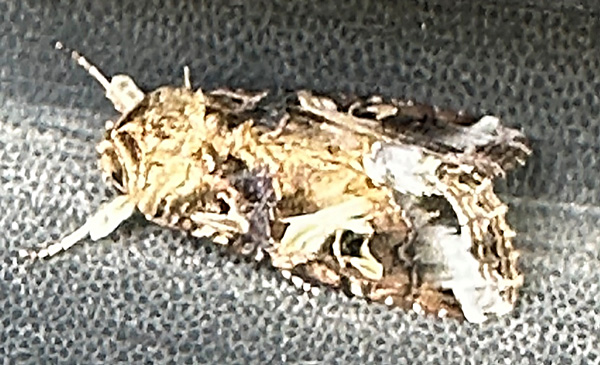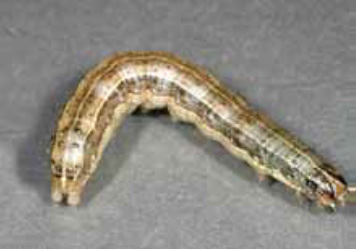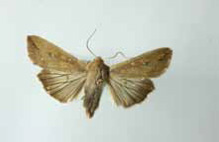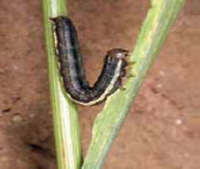There have been some significant insect infestations this growing season around the state. Two of the more widespread pests have been lepidoptera larvae (worms): the fall armyworm (Spodoptera frugiperada) and the armyworm (Pseudaletia unipuncta). These pests have been so problematic that many wheat producers are wondering what's going to happen the rest of the growing season, and how they may affect the 2025 wheat planting.
Fall armyworm (FAW)
Adults are a light brown/dark brown mottled color (Figure 1), and are typical of the noctuid moths, which mainly hide during the day and fly around depositing eggs at night. Adults cause no problems other than depositing the eggs from which the voracious feeding larvae hatch. These larvae feed on just about anything green and have been a problem this year, mainly in brome fields and other grassy areas. Larvae can be identified by the 4 dark spots, in the form of a square, on the top of the 8th abdominal segment (Figure 2).
Fortunately, many corn and sorghum fields have missed significant infestations so far, but as wheat planting approaches, fall armyworm problems are possible. However, reportedly, FAWs do not overwinter in Kansas. Thus, we may have one more generation of FAWs, but hopefully, most adults have emerged by the middle of September and migrate to overwintering sites without causing any damage to wheat.

Figure 1. Fall armyworm adult. Photo taken August 26, 2025, by J. Whitworth, K-State Research and Extension.

Figure 2. Fall armyworm larva. Photo by K-State Entomology.
Armyworms (ARW)
ARW adults are mostly light brown with a white spot on each forewing (Figure 3). Larvae are darker with several conspicuous light-colored stripes on both sides of their bodies (Figure 4), and they present a somewhat different problem than the FAW, because they do overwinter in Kansas. Therefore, the larvae may be around when the 2025 planted crop germinates. Thus, planting as late as possible is important, as is destroying all volunteer wheat at least 2 weeks prior to planting. This is also important because it is the female moth that initiates the infestation by where she deposits her eggs, and she won't deposit any eggs unless she detects some greenery for a potential food source for the developing larvae. From past experience with armyworm infestations, they may continue to feed until temperatures dip into the mid-20s °F for a couple of hours. Armyworms seem to overwinter mostly as mature larvae, but it has been reported that they can also overwinter as pupae and/or adults. Thus, fall armyworms should not be a problem for the fall-planted wheat crop, but armyworms might be, especially in early-planted fields.

Figure 3. Armyworm adult. Photo by K-State Entomology.

Figure 4. Armyworm larva. Photo by K-State Entomology.
Double-cropped sorghum and soybeans
Armyworms also still have the potential to cause problems in double-cropped sorghum and soybeans. In sorghum, when they feed on the kernels in the head, just like corn earworms, they are feeding on the marketable product. But potential losses can be relatively well calculated by using 5% loss/worm/head. Armyworms, unlike corn earworms, are not antagonistic or cannibalistic, so there can actually be several worms feeding per head. Double-cropped sorghum should only be vulnerable until the soft dough stage.
These armyworms can also feed on soybeans. They do not seem to be as attracted to soybeans, but much like corn earworms, they can feed directly on the bean through the pod, thus causing losses relatively quickly.
For either crop, double-planted soybeans or sorghum, continue to monitor these larvae until the soft dough stage in sorghum or until no worms can be detected in soybeans. If treatment is justified for either crop, or wheat, please refer to the K-State Insect Management Guides for sorghum, soybeans, or wheat for lists of insecticides registered for these pests and treatment thresholds. Insecticide seed treatments for wheat are not effective against armyworms or army cutworms.
Army cutworms
One other worm to consider is the Army cutworm (Euxoa auxiliaris). These moths migrate back into Kansas in the fall, looking for any greenery on which to deposit their eggs. So, they will not be the same problem as armyworms, as their feeding will be ending this fall, but the army cutworms will just be starting their feeding and culminate in the common "Miller moths" in the spring.
The best ways to help mitigate an infestation in fall-planted wheat from any of these worms are to plant as late as possible and destroy all volunteer wheat at least 2 weeks prior to planting.
Jeff Whitworth, Entomology Extension Specialist
jwhitwor@ksu.edu
Tags: insects armyworms fall armyworms